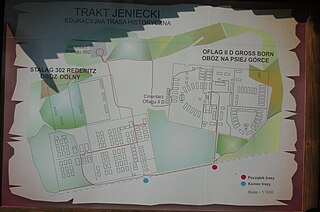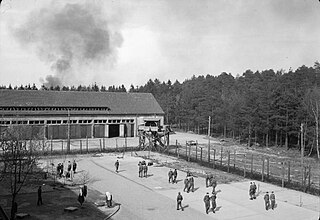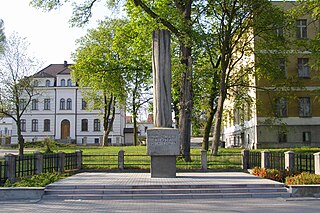
Legnickie Pole is a village in Legnica County, Lower Silesian Voivodeship, in south-western Poland. It is the seat of the administrative district (gmina) called Gmina Legnickie Pole.

Oflag VIII-E was a World War II German prisoner-of-war camp for Allied general officers (Offizierlager) located in Jánské Koupele in German-occupied Czechoslovakia.

Oflag II-D Gross Born (Grossborn-Westfalenhof) was a World War II German prisoner-of-war camp located at Gross Born, Pomerania, near Westfalenhof (Kłomino). It housed Polish and French officers.

Oflag XIII-B was a German Army World War II prisoner-of-war camp for officers (Offizierslager), originally in the Langwasser district of Nuremberg. In 1943 it was moved to a site 3 km (1.9 mi) south of the town of Hammelburg in Lower Franconia, Bavaria, Germany.

Stalag IV-B was one of the largest prisoner-of-war camps in Germany during World War II. Stalag is an abbreviation of the German Stammlager. It was located 8 km (5.0 mi) north-east of the town of Mühlberg in the Prussian Province of Saxony, just east of the Elbe river and about 30 mi (48 km) north of Dresden. From 1944 to 1945 it belonged to the Province of Halle-Merseburg. Now, the area is in Brandenburg. A sub-camp, sometimes identified as Stalag IV-B/Z,Stalag 304 or Stalag IV-H was located at Zeithain, 10 km (6.2 mi) to the south in Saxony.

Oflag VI-B was a World War II German prisoner-of-war camp for officers (Offizerlager), 1 km (0.6 mi) southwest of the village of Dössel in Germany.

Stalag VIII-F was a German prisoner-of-war camp for Soviet Red Army and Polish Home Army prisoners during World War II. It was located at the northern end of a Germany Army training area at Lamsdorf, Silesia, just to the north of Stalag VIII-B.

Oflag VII-B was a World War II German prisoner-of-war camp for officers (Offizierlager), located in Eichstätt, Bavaria, about 100 km (62 mi) north of Munich.

Oflag X-B was a World War II German prisoner-of-war camp for officers (Offizierlager) located in Nienburg am Weser, Lower Saxony, in north-western Germany. Adjacent to it was the enlisted men's camp (Stammlager) Stalag X-C.

Camp Fünfeichen was a World War II German prisoner-of-war camp located in Fünfeichen, a former estate within the city limits of Neubrandenburg, Mecklenburg, northern Germany. Built as Stalag II-A Neubrandenburg in 1939, it was extended by the officer camp Oflag II-E in 1940. After the Soviet takeover in 1945 until 1949 it was used as special camp, NKVD-camp Nr. 9 of the Soviet secret service (NKVD). Today, the site of the camp is a memorial.

Oflag 79 was a German World War II prisoner-of-war camp for Allied officers. The camp was located at Waggum near Braunschweig in Germany, also known by the English name of Brunswick. It was located in a three-story brick building that had previously been the home of a German parachute regiment, near the Hermann Göring aircraft engine factory.

Oflag X-C was a German World War II prisoner-of-war camp for officers (Offizierlager) in Lübeck in northern Germany. The camp was located on the corner of Friedhofsallee and Vorwerkstrasse, close to Lübeck's border with the town of Schwartau, and is often cited as being located in Schwartau rather than Lübeck.

Stalag XVIII-A was a World War II German Army (Wehrmacht) prisoner-of-war camp located to the south of the town of Wolfsberg, in the southern Austrian state of Carinthia, then a part of Nazi Germany. A sub-camp Stalag XVIII-A/Z was later opened in Spittal an der Drau about 100 km (62 mi) to the west.

Oflag VII-D was a World War II German prisoner-of-war camp for officers (Offizierlager) located in Tittmoning Castle in south-eastern Bavaria.

Oflag XIII-A, Oflag XIII-B and Oflag XIII-D were all German World War II prisoner-of-war camp for officers (Offizierlager). They were all located on the old Nazi party rally grounds in Langwasser, Nuremberg, in northern Bavaria. They were adjacent to Stalag XIII-D.

Stalag XIII-C was a German Army World War II prisoner-of-war camp (Stammlager) built on what had been the training camp at Hammelburg, Lower Franconia, Bavaria, Germany.

Oflag 64 was a World War II German prisoner-of-war camp for officers located at Szubin a few miles south of Bydgoszcz, in Pomorze, Poland, which at that time was occupied by Nazi Germany. It was probably the only German POW camp set up exclusively for U.S. Army ground component officers. At most other camps there were several nationalities, although they were usually separated into national compounds.

Oflag XXI-B and Stalag XXI-B were World War II German prisoner-of-war camps for officers and enlisted men, located at Szubin a few miles southwest of Bydgoszcz, Poland, which at that time was occupied by Nazi Germany.

Oflag XXI-C was a German Army World War II prisoner-of-war camp for officers (Offizierlager) located in Ostrzeszów in German-occupied Poland. It held mostly Norwegian officers arrested in 1942 and 1943, but also Dutch, Italian, Serbian and Soviet POWs. Originally most Norwegian soldiers and officers had been released after the end of the Norwegian campaign, but as resistance activities increased, the officers were rearrested and sent to POW camps.

Nazi Germany operated around 1,000 prisoner-of-war camps during World War II (1939-1945).

















